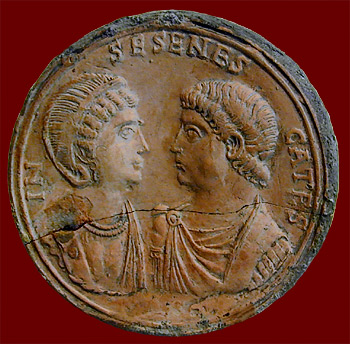Metamorphoses 8.616-724

Why is this fourth-century CE Roman terracotta plaque depicting a married couple an appropriate illustration for the story of Baucis and Philemon? Hint: read the inscription, IN SE SENESCATES (= senescatis). Here are some detailed questions about this story, which was possibly invented by Ovid:
- How does Ovid introduce this story? What "truth" is it intended to demonstrate? What visual "proof" does Lelex refer to? Describe the poetic effects created by the phrase tiliae contermina quercus (line 620). Why these trees? What are mergis fulicisque and why is their presence in this place significant?
- What gods visit this place? Explain the significance of Atlantiades, caducifer, and positis alis (line 627). Point out the figures of speech and other special effects that make lines 628-636 so effective in contrasting the first reception of the gods and the reception given them by Baucis and Philemon. What Old Testament stories are similar to this one?
- How does Ovid describe the old couple's preparations for the dinner (lines 637-663)? What are the key words which characterize their hospitality? The late sixteenth-century German painter Adam Elsheimer illustrated this scene and captures some of Ovid's effects. This brazier and cooking pot from Pompeii demonstrates what Ovid means by the parvo aeno under which Baucis places the twigs. This lectus, though more elaborate than that described by Ovid here, shows the couch frames that the Roman used for dining, though their cushions were more typically stuffed with down than with the marsh grass described here. Also, Roman tables normally had three legs; what is significant about the one owned by Baucis and Philemon?
- What are the courses of the meal served by Baucis and Philemon (lines 663-678)? What do all the ingredients have in common? Point out some of the ways that Ovid contrasts this meal with those more typically served by wealthy Romans? What is the best part of the meal (lines 677-678)?
- How do Baucis and Philemon find out that their guests are not mortal? What role does the goose play (see this sixteenth-century German illustration)? How does the very brief response of the gods (lines 689-693) contrast with the long description of the dinner? How does Ovid emphasize the difficulty that the old people have in following the gods (lines 683-684)?
- Why does Ovid describe the punishment of the wicked neighbors in only three words (mersa palude cetera (lines 696-697)? This scene is brilliantly rendered in a painting by Peter Paul Rubens. Contrast this with Ovid's description of what happens to the cottage of Baucis and Philemon (lines 699-702). What does the word caelatae (line 702) recall? Hint: look at line 668).
- What do Baucis and Philemon ask for when told that a special wish will be granted? What words does Ovid use to emphasize their closeness in lines 706-719, especially in the description of their transformation into trees? This sixteenth-century German illustration portrays their transformation, but I think this modern German sculpture conveys Ovid's idea more closely and movingly. Do you agree? What is the moral that Lelex draws from this story (line 724)?